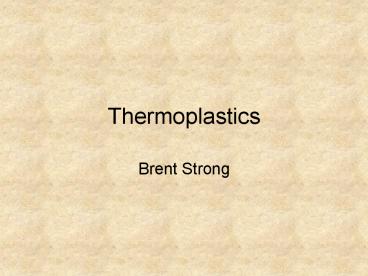Thermoplastics - PowerPoint PPT Presentation
1 / 11
Title:
Thermoplastics
Description:
Physical and chemical properties are those of the resin ... High processing temperatures (especially advanced thermoplastics) Thermoplastic Thermoforming ... – PowerPoint PPT presentation
Number of Views:5964
Avg rating:3.0/5.0
Title: Thermoplastics
1
Thermoplastics
- Brent Strong
2
Thermoplastics and Thermosets
Advanced Thermoplastic
Advanced Thermoset
High Cost High temperature capabilities High
strength High modulus Good fiber wet-out Brittle
High cost Solvent resistance High
toughness Poor wet-out High strength
Engineering Thermoset
Engineering Thermoplastic
Low cost Excellent fiber wet-out Moderate
strength Brittle
Low cost Standard TP mfg Short fibers Moderate
strength Good toughness
3
Engineering Thermoplastics
- Most commonly used engineering thermoplastics as
matrices - Nylon
- Polycarbonate (PC)
- Polyethylene terephthalate (PET)
- Polypropylene (PP)
- Stronger and stiffer but lower toughness
- Physical and chemical properties are those of the
resin
4
Engineering Thermoplastics - effect of fiberglass
Coefficient of Thermal Expansion (in/in/oF x10-5)
Izod Impact (ft-lb/in)
Flex Modulus (ksi)
Tensile Strength (ksi)
Elongation ()
- 2000 4 80 40
- 1500 3 60 30
- 1000 2 40 20
- 1 500 1 20 10
CTE Flex Modulus Izod Impact Elongation Tensile
Strength
0 10 20 30 40 50
Scales for each property
5
Thermoplastic - Advantages
- Toughness
- Solvent resistance
- Re-molding
- Processing by conventional thermoplastic method
(engineering thermoplastics with very short
fibers) - Processing times
6
Advanced Thermoplastics
- All highly aromatic
- Most common types
- Thermoplastic polyimides (TPI, PAI, PEI, PBI)
- Polyetheretherketone (PEEK, and related)
- Sulfone and related (PSU, PAS, PES, PPS)
- Liquid crystal polymers (LCP)
- Fluoropolymers (PTFE, PVDF)
7
High Performance Thermoplastics
Polyether ether ketone (PEEK)
Polyphenylene sulfide (PPS)
)
(
n
Polyetherimide (PEI)
8
Thermoplastics - Problems
- Fiber wet-out (long fibers)
- Vertron concept
- Melt coating
- Film infusion
- Co-mingling fibers
- Surface powder
- High processing temperatures (especially advanced
thermoplastics)
9
Thermoplastic - Thermoforming
Press (in two modes)
Blanks
Clamp
Finished Part
Oven
Pressing
Clamping
10
Thermoplastics
11
Thank you
- A. Brent Strong































